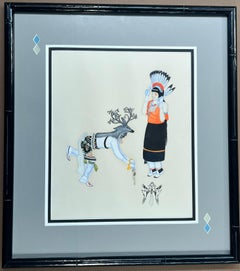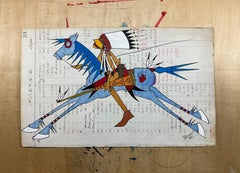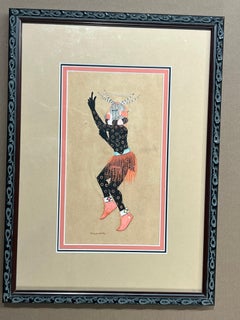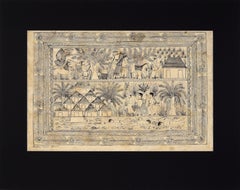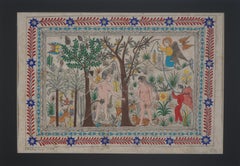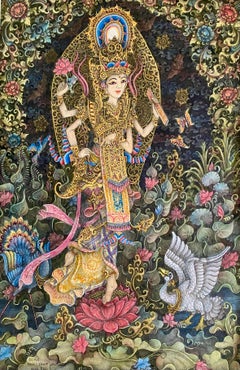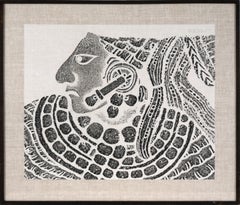Tribal Drawings and Watercolor Paintings
to
4
7
1
2
Overall Width
to
Overall Height
to
7
3
3
1
1
7,116
7,014
4,989
3,125
609
565
483
427
378
303
244
177
86
61
6
4
8
5
4
3
2
2
2
2
1
1
1
1
1
8
6
5
4
3
5
2
7
1
Style: Tribal
Deer Dance, painting by Tonita Pena, Santa Fe, Cochiti, Pueblo, male, female
Located in Santa Fe, NM
Deer Dance, painting by Tonita Pena, Santa Fe, Cochiti, Pueblo, male, female
Tonita Peña (born 1893 in San Ildefonso, died 1949 in Kewa Pueblo, New Mexico) was born as Quah Ah (meaning white coral beads) but also used the name Tonita Vigil Peña and María Antonia Tonita Peña. Peña was a renowned Pueblo artist, specializing in pen and ink on paper embellished with watercolor. She was a well-known and influential Native American artist and art teacher of the early 1920s and 1930s.
Tonita Peña was born on May 10, 1893, at San Ildefonso Pueblo, to Ascensión Vigil Peña and Natividad Peña of San Ildefonso Pueblo, New Mexico. When she was 12, her mother and younger sister died, as a result of complications due to the flu. Her father was unable to care for her and she was taken to Cochití Pueblo and was brought up by her aunt Martina Vigil Montoya, a prominent Cochití Pueblo potter. Peña attended St. Catherine Indian School in Santa Fe.
Edgar Lee Hewett, an anthropologist involved in supervising the nearby Frijoles Canyon excavations (now Bandelier National Monument) was instrumental in developing the careers of several San Ildefonso “self-taught” artists including Tonita Peña. Hewett purchased Peña's paintings for the Museum of New Mexico and supplied her with quality paint and paper. Peña began gaining more notoriety by the end of the 1910s selling an increasing amount of her work to collectors and the La Fonda Hotel. Much of this early work was done of Pueblo cultural subject matter, in a style inspired by historic Native American works, however, her use of an artist's easel and Western painting mediums gained her acceptance among her European-American contemporaries in the art world. At the age of 25, she exhibited her work at museums and galleries in the Santa Fe and Albuquerque area.
In the early 1920s, Tonita did not know how much her painting sold for at the Museum of New Mexico, so she wrote letters to the administrators because a local farmer was worried that she got paid too little.
In the 1930s Peña was an instructor at the Santa Fe Indian School and at the Albuquerque Indian School and the only woman painter of the San Ildefonso Self-Taught Group, which included such noted artists as Alfonso Roybal, Julian Martinez, Abel Sánchez (Oqwa Pi), Crecencio Martinez, and Encarnación Peña. As children, these artists attended San Ildefonso day school which was part of the institution of the Dawes Act of 1887, designed to indoctrinate and assimilate Native American children into mainstream American society.
In 1931, Tonita Peña exhibited at the Exposition of Indian Tribal Arts which was presented at the Grand Central Art Galleries in New York City. Works from this exhibition were shown at the 1932 Venice Biennial. That year is the only time Native American artists have shown in the official United States pavilion at that biennial, and Tonita Peña's paintings were part of that exhibition.[1 Her painting Basket Dance, that had shown in the Venice Biennial was acquired by the Whitney Museum of American Art in New York for $225. This was the highest price paid up to this time for a Pueblo painting...
Category
1940s Tribal Drawings and Watercolor Paintings
Materials
Paint, Paper
Indian Warrior on Pale Blue Horse (Plains Indians Ledger Art) Blackfeet Nation
Located in Cody, WY
UNIQUE piece. TITLE: OUT FOR MORE. John Isaiah Pepion is a noted contemporary indigenous artist and renowned graphic ledger artist, muralist, and educator based on the Blackfeet Nati...
Category
2010s Tribal Drawings and Watercolor Paintings
Materials
Paper, Ink, Acrylic, Color Pencil
Corn Kachina, by Riley Sunrise, Quoyavema, Hopi, Kachina, Dancer, painting
Located in Santa Fe, NM
Corn Kachina, by Riley Sunrise, Quoyavema, Hopi, Kachina, Dancer, painting
Artist Signature - Riley Sunrise (1914-2006) Quoyavema “Another of the earlier Hopi artists, Riley Sunrise (Quoyavema) worked with Fred Kabotie and Waldo Mootzka in illustrating John Louw Nelson’s Rhythm for Rain. He is also known as Quoyavema or Kwayeshva, according to Nelson. His paintings are comparable to Fred Kabotie’s, with some of them showing more action and most of them revealing less detail. Sunrise is represented in the collections of the Denver Art Museum, Gilcrease Institute (Tulsa), and the Southwest Museum. The Museum of the American Indian in New York has an extensive collection of his paintings of native Hopi dances.” (Clara Lee Tanner: Southwest Indian...
Category
1940s Tribal Drawings and Watercolor Paintings
Materials
Paint, Paper
Illustration of a Village by the River - Amate Bark Drawing in Ink
Located in Soquel, CA
Illustration of a Village by the River - Amate Bark Drawing in Ink
Illustration with people in a village by Cristino Florez Medina (Mexican, 1937-2007). This piece is divided horizo...
Category
Late 20th Century Tribal Drawings and Watercolor Paintings
Materials
India Ink, Handmade Paper
Illustration of the Garden of Eden- Amate Bark Drawing in Ink
Located in Soquel, CA
Illustration of the Garden of Eden done with Mexican Amate Bark Drawing in Ink
Vibrant illustration with Adam and Eve in the Garden of Eden by Cristino Florez Medina (Mexican, 1937-...
Category
Late 20th Century Tribal Drawings and Watercolor Paintings
Materials
India Ink, Handmade Paper
“Saraswati”
Located in Southampton, NY
Very finely executed ink and watercolor painting depicting the Balinese goddess, Saraswati. Signed lower left “De Mus, keliki-Kawan, Ubud, Bali”. The ...
Category
1970s Tribal Drawings and Watercolor Paintings
Materials
Ink, Watercolor, Archival Paper
$1,200 Sale Price
33% Off
No title
Located in Tel Aviv - Jaffa, IL
Ballpoint Pens, Crayons And Colored Pencil On Cardboard
Unique piece
Hand signed and dated on the reverse
Category
Early 2000s Tribal Drawings and Watercolor Paintings
Materials
Ink, Cardboard, Pen, Color Pencil
“Untitled”
Located in Southampton, NY
Provocative watercolor, gouache on paper Balinese tribal artwork. Not signed. Circa 1950. Condition is very good. No issues. Finely painted and meticulously detailed artwork of a ta...
Category
1950s Tribal Drawings and Watercolor Paintings
Materials
Paper, Watercolor, Gouache
$750 Sale Price
46% Off
No title
Located in Tel Aviv - Jaffa, IL
Ballpoint Pens, Crayons And Colored Pencil On Cardboard
Unique piece
Hand signed and dated on the reverse
Category
Early 2000s Tribal Drawings and Watercolor Paintings
Materials
Ink, Pen, Color Pencil, Cardboard
Arab Market's Scene, Pencil on Brown Paper by Georges Manzana Pissarro
Located in London, GB
Arab Market Scene by Georges Manzana Pissarro (1871-1961)
Pencil on brown paper
17.7 x 26.7 cm (7 x 10 ½ inches)
Signed with studio stamp lower left
This work is accompanied by a ce...
Category
1940s Tribal Drawings and Watercolor Paintings
Materials
Paper, Pencil
Related Items
Fine 1700's Italian Old Master Ink & Wash Drawing Roman Allegorical Providenza
Located in Cirencester, Gloucestershire
'Providenza'
Italian School, 18th century
ink and wash drawing on paper, framed within a light oak wood frame (behind glass)
image size: 10.5 x 7 inches
overall framed: 17 x 13 inche...
Category
18th Century Tribal Drawings and Watercolor Paintings
Materials
Ink, Watercolor, Archival Paper
Fine 1700's Italian Old Master Ink & Wash Drawing Roman Allegorical Africa
Located in Cirencester, Gloucestershire
'Africa'
Italian School, 18th century
ink and wash drawing on paper, framed within a light oak wood frame (behind glass)
image size: 10.5 x 7 inches
overall framed: 17 x 13 inches
co...
Category
18th Century Tribal Drawings and Watercolor Paintings
Materials
Ink, Watercolor, Archival Paper
Fine 1700's Italian Old Master Ink & Wash Drawing Roman Allegorical India
Located in Cirencester, Gloucestershire
'India'
Italian School, 18th century
ink and wash drawing on paper, framed within a light oak wood frame (behind glass)
image size: 10.5 x 7 inches
overall framed: 17 x 13 inches
con...
Category
18th Century Tribal Drawings and Watercolor Paintings
Materials
Ink, Watercolor, Archival Paper
Contemporary Drawing "The essential". Pastel, Ink And Colored Pencils
Located in Bogotá, Bogotá
Drawing based on natural pigments from leaves, flowers and bark and Pastel, Pencil, flower petals, Color and Ink on Paper. In my work there is a cross with the gaze of animals, a rem...
Category
2010s Tribal Drawings and Watercolor Paintings
Materials
Oil Pastel, Ink, Pencil, Color Pencil, Paper
Fine 1700's Italian Old Master Ink & Wash Drawing Roman Allegorical Magnaminita
Located in Cirencester, Gloucestershire
'Mgnaminia'
Italian School, 18th century
ink and wash drawing on paper, framed within a light oak wood frame (behind glass)
image size: 10.5 x 7 inches
overall framed: 17 x 13 inches...
Category
18th Century Tribal Drawings and Watercolor Paintings
Materials
Ink, Watercolor, Archival Paper
Chinatown, San Francisco
By Edward Wilson Currier
Located in London, GB
'Chinatown, San Francisco', gouache on fine art paper, by Edward Wilson Currier (1903). Spofford Alley in San Francisco's Chinatown is best known for an address (number 36) where Dr. Sun Yat-Sen plotted the overthrow of China's last dynasty. During Prohibition, it was the site of turf battles over local bootlegging and protection rackets. Today it is lined with seniors' community centres. However, the quiet alley livens up in the evenings when a Chinese orchestra strikes up a tune, mah-jongg games begin with a cascade of clicking tiles, and barbers and florists use the pretence of sweeping their doorsteps to gossip. In this artist's depiction, a man smokes a long-stemmed Chinese pipe under the awning and colourful lanterns hanging from the wooden supports while a child looks on. The artwork is interesting from several standpoints including architectural, cultural and historical. Shortly after this work was painted, the neighbourhood was completely destroyed in the 1906 earthquake that levelled most of the city. From 1910 to 1940, Chinese immigrants were detained at the Angel Island...
Category
Early 1900s Tribal Drawings and Watercolor Paintings
Materials
Paper, Gouache
Glastonbury Abbey
Located in Middletown, NY
Ink wash with watercolor in sepia and black, and blue, on buff wove watercolor paper, 14 1/4 x 10 1/4 inches (360 x 260 mm). 1/4" of the lower right corner is lost, minor crack (doe...
Category
Mid-19th Century Tribal Drawings and Watercolor Paintings
Materials
Ink, Watercolor, Handmade Paper
Fall to Grace
Located in Philadelphia, PA
"Fall to Grace" is an original ink and watercolor painting on paper mounted to wood by artist Robert Kraiza measuring 19in height x 9in width.
Artist Statement // In my work I invoke a whimsical world inspired by Victorian and Edwardian eras. To me they represent a romantic time period that has roots that extend directly into the modern world, both good and bad. The customs and aesthetics of the period are both fascinating and breathtaking but a vast portion of the population was victim to subjugation. It has since been eradicated on paper but still permeates to this day. I am exploring an imagined supernatural world hidden just out of sight where these woman could escape. This is an evolution from my earlier work set in the same time period with a continuous thread of humans and their animal companions.
Through witchcraft these women find strength in their abilities and each other to leave the oppressive world they inhabit behind and escape to the woods to their Covendom, the boundary that defines the territory of their coven. They shed their customs, their corsets, and their concerns at the edge of the forest and gather among the trees to explore their magical potential with their familiars at the side.
This body of work is exploring multiple media with a consistent theme and setting; combining watercolor painting, pen and ink illustrations, and graphite drawings. All pieces are created in monochrome on hot press watercolor paper mounted on wood with a gold painted border reminiscent of daguerreotype frames. Watercolor allows me to achieve results ranging from soft ethereal layered washes similar to oil glazes to precise minute details I include in all of my works.
Bio // ROBERT KRAIZA (pronounced: cry-zuh) is an illustrator and fine artist who lives and works in Philadelphia, Pennsylvania. He studied Media Arts and Animation at the Art Institute of Philadelphia. Interested in many media, he often paints in monochrome watercolor on a small scale, inspired by the Victorian era and whimsical dreams in both his art and personal aesthetic. Depicting fantasy worlds from the hidden life of nineteenth century witches to miniature children...
Category
21st Century and Contemporary Tribal Drawings and Watercolor Paintings
Materials
Ink, Watercolor, Archival Paper
Fine 1700's Italian Old Master Ink & Wash Drawing Roman Allegorical Napoli
Located in Cirencester, Gloucestershire
'Napoli'
Italian School, 18th century
ink and wash drawing on paper, framed within a light oak wood frame (behind glass)
image size: 10.5 x 7 inches
overall framed: 17 x 13 inches
co...
Category
18th Century Tribal Drawings and Watercolor Paintings
Materials
Ink, Watercolor, Archival Paper
Thunderstorm Over Boston
By James McBey
Located in Storrs, CT
Thunderstorm over Boston. July 14, 1930. Ink and watercolor on paper. 10 5/8 x 17 5/8 (sheet 12 x 19 1/4). Signed and dated and titled in ink, lower right; titled verso and annotated...
Category
Mid-20th Century Tribal Drawings and Watercolor Paintings
Materials
India Ink, Watercolor
Fawn
By Henry Hablak
Located in Philadelphia, PA
"Fawn" is an original ink, colored pencil, and gouache on paper artwork by Henry Hablak measuring 30"h x 22"w.
Henry Hablak is a tattoo artist and illustrator based out of Philadel...
Category
2010s Tribal Drawings and Watercolor Paintings
Materials
Ink, Color Pencil, Gouache, Paper
Yves in Tangier. From the Fashion series
Located in Miami Beach, FL
The artist has covered New York collections for over 16 years and has interviewed, as a journalist, several fashion designers and personalities for different publications. He loves t...
Category
21st Century and Contemporary Tribal Drawings and Watercolor Paintings
Materials
Paper, Gouache, Acrylic
Previously Available Items
Bonampak, Sacerdote, Stela 1 (VI-VIII D.C.) Original Rubbing of Mayan Carving
Located in Soquel, CA
Bonampak, Sacerdote, Stela 1 (VI-VIII D.C.) Original Rubbing of Mayan Carving
Bold rubbing of a Mayan Stela by Nicolette (20th Century). This piece is a rubbing from Stela 1 at Bona...
Category
1970s Tribal Drawings and Watercolor Paintings
Materials
India Ink, Mulberry Paper
H 29.5 in W 33.75 in D 1.25 in
Pueblo Dancers, painting, by Tonita Pena, Cochiti, Pueblo, Santa Fe, Native Amer
Located in Santa Fe, NM
Pueblo Dancers, painting, by Tonita Pena, Cochiti, Pueblo, Santa Fe, Native Amer
Tonita Peña (born 1893 in San Ildefonso, died 1949 in Kewa Pueblo, New Mexico) was born as Quah Ah (meaning white coral beads) but also used the name Tonita Vigil Peña and María Antonia Tonita Peña. Peña was a renowned Pueblo artist, specializing in pen and ink on paper embellished with watercolor. She was a well-known and influential Native American artist and art teacher of the early 1920s and 1930s.
Tonita Peña was born on May 10, 1893, at San Ildefonso Pueblo, to Ascensión Vigil Peña and Natividad Peña of San Ildefonso Pueblo, New Mexico. When she was 12, her mother and younger sister died, as a result of complications due to the flu. Her father was unable to care for her and she was taken to Cochití Pueblo and was brought up by her aunt Martina Vigil Montoya, a prominent Cochití Pueblo potter. Peña attended St. Catherine Indian School in Santa Fe.
Edgar Lee Hewett, an anthropologist involved in supervising the nearby Frijoles Canyon excavations (now Bandelier National Monument) was instrumental in developing the careers of several San Ildefonso “self-taught” artists including Tonita Peña. Hewett purchased Peña's paintings for the Museum of New Mexico and supplied her with quality paint and paper. Peña began gaining more notoriety by the end of the 1910s selling an increasing amount of her work to collectors and the La Fonda Hotel. Much of this early work was done of Pueblo cultural subject matter, in a style inspired by historic Native American works, however, her use of an artist's easel and Western painting mediums gained her acceptance among her European-American contemporaries in the art world. At the age of 25, she exhibited her work at museums and galleries in the Santa Fe and Albuquerque area.
In the early 1920s, Tonita did not know how much her painting sold for at the Museum of New Mexico, so she wrote letters to the administrators because a local farmer was worried that she got paid too little.
In the 1930s Peña was an instructor at the Santa Fe Indian School and at the Albuquerque Indian School and the only woman painter of the San Ildefonso Self-Taught Group, which included such noted artists as Alfonso Roybal, Julian Martinez, Abel Sánchez (Oqwa Pi), Crecencio Martinez, and Encarnación Peña. As children, these artists attended San Ildefonso day school which was part of the institution of the Dawes Act of 1887, designed to indoctrinate and assimilate Native American children into mainstream American society.
In 1931, Tonita Peña exhibited at the Exposition of Indian Tribal Arts which was presented at the Grand Central Art Galleries in New York City. Works from this exhibition were shown at the 1932 Venice Biennial. That year is the only time Native American artists have shown in the official United States pavilion at that biennial, and Tonita Peña's paintings were part of that exhibition.[1 Her painting Basket Dance, that had shown in the Venice Biennial was acquired by the Whitney Museum of American Art in New York for $225. This was the highest price paid up to this time for a Pueblo painting...
Category
1940s Tribal Drawings and Watercolor Paintings
Materials
Paint, Paper
No title
Located in Tel Aviv - Jaffa, IL
Ballpoint Pens, Crayons And Colored Pencil On Cardboard
Unique piece
Hand signed and dated on the reverse
Category
Early 2000s Tribal Drawings and Watercolor Paintings
Materials
Ink, Cardboard, Pen, Color Pencil
Untitled (Royal Portrait)
By Chris Ofili
Located in Toronto, Ontario
Chris Ofili's Royal Portraits are the most iconic and popular works from his fascinating oeuvre.
They highlight an important element in his work; the celebration of Afrocentric li...
Category
21st Century and Contemporary Tribal Drawings and Watercolor Paintings
Materials
Watercolor
Tribal drawings and watercolor paintings for sale on 1stDibs.
Find a wide variety of authentic Tribal drawings and watercolor paintings available for sale on 1stDibs. Works in this style were very popular during the 21st Century and Contemporary, but contemporary artists have continued to produce works inspired by this movement. Frequently made by artists working with Paper, and Paint and other materials, all of these pieces for sale are unique and have attracted attention over the years. Not every interior allows for large Tribal drawings and watercolor paintings, so small editions measuring 5.12 inches across are also available. Prices for drawings and watercolor paintings made by famous or emerging artists can differ depending on medium, time period and other attributes. On 1stDibs, the price for these items starts at $750 and tops out at $2,700, while the average work sells for $1,053.
